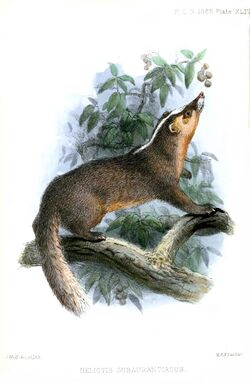Biology:Formosan ferret-badger
| Formosan ferret-badger | |
|---|---|

| |
| Illustration by Joseph Wolf | |
| Scientific classification | |
| Domain: | Eukaryota |
| Kingdom: | Animalia |
| Phylum: | Chordata |
| Class: | Mammalia |
| Order: | Carnivora |
| Family: | Mustelidae |
| Genus: | Melogale |
| Species: | M. subaurantiaca
|
| Binomial name | |
| Melogale subaurantiaca (Swinhoe, 1862)
| |
The Formosan ferret-badger (Melogale subaurantiaca) is a mustelid species endemic to Taiwan.
Taxonomy
It was formerly thought to be conspecific with the Chinese ferret-badger (M. moschata), but a 2019 genetic study found it to represent a distinct species, and the American Society of Mammalogists later reclassified it as a distinct species.[1] However, many authorities like the IUCN Red List still consider it conspecific with M. moschata.[2]
Distribution
The species is endemic to the island of Taiwan.[3]
Reproduction
Male Formosan ferret-badgers produce sperm between the months of February and September, and mate with females between March and October. The species is thought to have a litter size of two, and breeds once a year.[4]
Threats
A 2015 study analyzing specimens of M. subaurantiaca collected between 2010 and 2013 found evidence of rabies in just under half of the sampled individuals, indicating that a rabies epidemic hit the species at some point prior to the study.[5] This was the first time rabies had been detected on Taiwan since it was declared rabies-free in 1961. The species is now thought to be a reservoir species for the rabies virus on Taiwan, and as of 2019, it has become an epidemic in eastern Taiwan; however, epidemics in western and southern Taiwan had subsided by then. Aside from the threats posed to the species, there have been reports of spillover from the ferret-badgers to pets and humans. Vaccination will be necessary to serve as a barrier to the disease and prevent further spillover.[6]
See also
References
- ↑ Rozhnov, V. V.; Korablev, M. P.; Abramov, A. V. (2019-03-01). "Systematics and Distribution of Ferret Badgers Melogale (Mammalia, Mustelidae) in Vietnam: First Genetic Data" (in en). Doklady Biological Sciences 485 (1): 47–51. doi:10.1134/S001249661902008X. ISSN 1608-3105. PMID 31197594. https://doi.org/10.1134/S001249661902008X.
- ↑ Duckworth, J.W.; Abramov, A.V.; Willcox, D.H.A.; Timmins, R.J.; Choudhury, A.; Roberton, S.; Long, B.; Lau, M. (2016). "Melogale moschata". IUCN Red List of Threatened Species 2016: e.T41626A45209676. doi:10.2305/IUCN.UK.2016-1.RLTS.T41626A45209676.en. https://www.iucnredlist.org/species/41626/45209676.
- ↑ Template:Cite mdd
- ↑ Pei, K.; Wang, Y. (1995). "Some Observations on the Reproduction of the Taiwan Ferret Badger (Melogale moschata subaurantiaca) in Southern Taiwan" (in en). Zoological Studies.
- ↑ Chang, Jen-Chieh; Tsai, Kuo-Jung; Hsu, Wei-Cheng; Tu, Yang-Chang; Chuang, Wei-Chieh; Chang, Chia-Yi; Chang, Shih-Wei; Lin, Te-En et al. (October 2015). "Rabies Virus Infection in Ferret Badgers (Melogale moschata subaurantiaca) in Taiwan: A Retrospective Study". Journal of Wildlife Diseases 51 (4): 923–928. doi:10.7589/2015-04-090. ISSN 0090-3558. PMID 26267459.
- ↑ Tu, Wen-Jane; Wang, Mei-Chuan; Jau, Guo-Chin; Tsai, Cheng-Ta; Lin, Chung-Ching; Inoue, Satoshi; Butudom, Prawit; Lai, Cheng-Hung et al. (2020-12-03). "A study of the temporal dynamics and human exposure to the Formosan ferret-badger (Melogale moschata subaurantiaca) rabies, 2013 to 2019, Taiwan" (in en-US). The Thai Journal of Veterinary Medicine 50 (4): 543–548. ISSN 0125-6491. https://he01.tci-thaijo.org/index.php/tjvm/article/view/246323.
Wikidata ☰ {{{from}}} entry
 |

